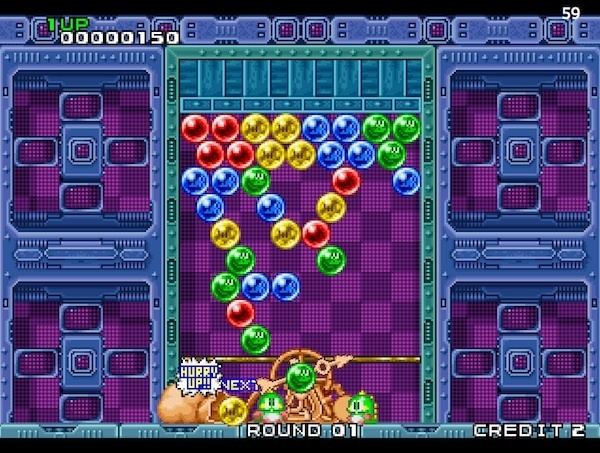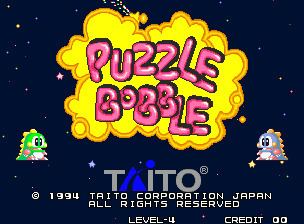7.2 /10 4 Votes
Designer(s) Seiichi Nakakuki Cabinet Upright Initial release date June 1994 | 4/5 GamesGames Composer(s) Kazuko Umino Arcade system Neo Geo Genre Puzzle video game | |||||||||||||||||||||||||||||||||
 | ||||||||||||||||||||||||||||||||||
Mode(s) Up to 2 players simultaneously Display Raster, standard resolution Publishers Taito, Nokia, Sega, SNK, SunSoft, Inc., Panasonic Corporation Of North America, GameBank Corp. Similar Puzzle Bobble games, Taito games, Puzzle video games | ||||||||||||||||||||||||||||||||||
Arcade longplay 291 puzzle bobble
Puzzle Bobble (Japanese: パズルボブル, Hepburn: Pazuru Boburu), also known as Bust-a-Move in North America, is a 1994 tile-matching arcade puzzle video game for one or two players created by Taito Corporation. It is based on Taito's popular 1986 arcade game Bubble Bobble, featuring characters and themes from that game. Its characteristically cute Japanese animation and music, along with its play mechanics and level designs, made it successful as an arcade title and spawned several sequels and ports to home gaming systems.
Contents
- Arcade longplay 291 puzzle bobble
- Puzzle bobble bust a move arcade gameplay
- Versions
- Gameplay
- Scoring system
- Two player mode
- Connections with Bubble Bobble
- Reception
- Tournaments
- References

Puzzle bobble bust a move arcade gameplay
Versions

Two different versions of the original game were released. Puzzle Bobble was originally released in Japan only in June 1994 by Taito Corporation, running on Taito's B System hardware (with the preliminary title "Bubble Buster"). Then, 6 months later in December, the international Neo Geo version of Puzzle Bobble was released. It was almost identical aside from being in stereo and having some different sound effects and translated text.

When set to the US region, the Neo Geo version displays the alternative title "Bust a Move" and features anti-drugs and anti-littering messages in the title sequence. The Bust-a-Move title was used for all subsequent games in the series in the United States and Canada, as well as for some (non-Taito published) console releases in Europe.
Gameplay

At the start of each round, the rectangular playing arena contains a prearranged pattern of coloured "bubbles". (These are actually referred to in the translation as "balls"; however, they were clearly intended to be bubbles, since they pop, and are taken from Bubble Bobble.) At the bottom of the screen, the player controls a device called a "pointer", which aims and fires bubbles up the screen. The colour of bubbles fired is randomly generated and chosen from the colors of bubbles still left on the screen.

The fired bubbles travel in straight lines (possibly bouncing off the side walls of the arena), stopping when they touch other bubbles or reach the top of the arena. If a bubble touches identically-colored bubbles, forming a group of three or more, those bubbles—as well as any bubbles hanging from them—are removed from the field of play, and points are awarded.
After every few shots, the "ceiling" of the playing arena drops downwards slightly, along with all the bubbles stuck to it. The number of shots between each drop of the ceiling is influenced by the number of bubble colors remaining. The closer the bubbles get to the bottom of the screen, the faster the music plays and if they cross the line at the bottom then the game is over.
The objective of the game is to clear all the bubbles from the arena without any bubble crossing the bottom line. Bubbles will fire automatically if the player remains idle. After clearing the arena, the next round begins with a new pattern of bubbles to clear. The game consists of 32 levels.
Scoring system
As with many popular arcade games, experienced players (who can complete the game relatively easily) become much more interested in the secondary challenge of obtaining a high score (which involves a lot more skill and strategy). Puzzle Bobble caters to this interest very well, featuring an exponential scoring system which allows extremely high scores to be achieved.
"Popped" bubbles (that is, bubbles of the same color which disappear) are worth 10 points each. However, dropped bubbles (that is, bubbles that were hanging from popped bubbles), are worth far more: one dropped bubble scores 20 points; two score 40; three score 80. This figure continues doubling for each bubble dropped, up to 17 or more bubbles which scores 1,310,720 points. It is possible to achieve this maximum on most rounds (sometimes twice or more), resulting in a potential total score of 30 million and beyond.
Bonus points are also awarded for completing a round quickly. The maximum 50,000-point bonus is awarded for clearing a round in 5 seconds or less; this bonus then drops down to zero over the next minute, after which no bonus is awarded.
Two player mode
There are no rounds in the two player game. Both players have an arena each (both visible on screen) and an identical arrangement of colored bubbles in each arena. When a player removes a large group (four bubbles or more) some of those removed are transferred to the opponent's arena, usually delaying their efforts to remove all the bubbles from their individual arena. In some versions, the two player game can also be played by one player against a computer opponent.
Connections with Bubble Bobble
The characters and theme of the game are based on the 1986 platform arcade game Bubble Bobble. An arrangement of the original Bubble Bobble background music is played in the game's end credits.
The two dinosaurs operating the pointer are called Bub and Bob (or Bubblun and Bobblun in Japan). Their graphics and animation are based directly on the original Bubble Bobble, only larger (very similar to Bubble Symphony which was released less than a month later). Less obvious is the fact that Puzzle Bobble also features all the enemies from Bubble Bobble, which are trapped inside the bubbles and fly out when the bubbles pop. Inspecting the bubbles closely, one can see the enemies twitching inside the bubbles.
Reception
Reviewing the Super NES version, Mike Weigand of Electronic Gaming Monthly called it "a thoroughly enjoyable and incredibly addicting puzzle game". He considered the two player mode the highlight, but also said that the one player mode provides a solid challenge. GamePro gave it a generally negative review, saying it "starts out fun but ultimately lacks intricacy and longevity." They elaborated that in one player mode all the levels feel the same, and that two player matches are over too quickly to build up any excitement. They also criticized the lack of any 3D effects in the graphics.
A reviewer for Next Generation, while questioning the continued viability of the action puzzle genre, admitted that the game is "very simple and very addictive". He remarked that though the 3DO version makes no significant additions, none are called for by a game with such simple enjoyment. GamePro's brief review of the 3DO version commented, "The move-and-shoot controls are very responsive and the simple visuals and music are well done. This is one puzzler that isn't a bust."
Tournaments
Puzzle Bobble is played at both Penny Arcade Expos, PAX East and PAX Prime. After being the 9-time (7 consecutive years at PAX East, 2010-2016, and the 2015-2016 PAX Prime) undefeated champion, Matthew A. Tom has declared that he is "retiring from competitive Puzzle Bobble playing."
